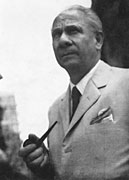He was born in Vasto (Chieti, Italy) in 1897. During his childhood, his family established in the district of La Boca, Buenos Aires.
An autodidact, his main expressive source were matter and color, with which he would later enliven compositions alternating figuration and abstraction. Early on he put on view a lean towards the avant-garde trends.
In 1925, a work he sent to the Salón Nacional attained a significant effect. Next year he performed his first individual exhibition at Asociación Amigos del Arte. In 1929 he became an Argentine citizen. This year, by means of Amigos del Arte, he was granted a fellowship to go to Paris, where he could appreciate the great classical masters. He was also deeply interested about the use of color by Henri Mattise and the treating of shapes by Pablo Picasso. Simultaneously he got in touch with the avant-garde circles: he met Torres García, Jean Arp and Enrico Prampolini, among others.
He took part, in 1932, of the Abstraction Creation Art non Figuratif group and, at the same time, he collaborated with the magazine edited by this group, together with artists such as Alexander Calder, Auguste Herbin, Georges Vantongerloo, etc.
Back in Buenos Aires in 1933, he showed abstract paintings and collages at Amigos del Arte. This exhibition, taken to be the first non-figurative art exposition ever performed in Argentina, was followed by another one in which he showed abstract sculptures completed in wire, iron plates and carved plaster. While neither the audience nor the critics were favorably impressed, Del Prete continued painting non-figurative works, not completely leaving, though, representative art.
Since 1937, the plastic artist Eugenia Crenovich, known as Yente, became his disciple and couple.
In 1954 Del Prete travelled to Europe and exhibited in Genoa, Milan and Como, Italy.
He presided over the Agrupación de Artistas no Figurativos (Non Figurative Artists Group), an alignment formed by Domingo Di Stefano, Pedro Gaeta and Eugenio Abal among others, which intended to humanize abstraction.
In 1957 he was invited to the IV San Pablo International Biennial and, two years later, he took part in the same event with twenty of his works, as a guest artist. The following year Del Prete’s works were included in the Argentine lots sent to the international biennials in Venice and Mexico.
By late 50s he adopted dripping, spots and splashes to work on large canvasses, close to an informalist aesthetics.
His scenographic works include, outstanding among others, those performed in Amigos del Arte for Estrella de mar (Starfish) and Magia Negra (Black Magic), and in the Teatro Colón for the opera Leyenda de Urutaú (The Legend of Urutaú).
Del Prete obtains the First Prize at the Salón de Acuarelistas and the Great Prize at the Salón Municipal in 1957, the Premio Palanza in 1958, the Great Honor Prize at the Salón Nacional in 1963 and, in Brussels, 1958, the International Great Prize.
He also was honored at the Salones de Mar del Plata and the Salones de la Provincia de Santa Fe. The major retrospective exhibitions of his works comprise the one organized by the Secretaría de Cultura de la Nación in Buenos Aires, (1950); the one performed by the Museo de Arte Moderno de Buenos Aires (1961), and others held at the Museo de Arte Contemporáneo in Santiago de Chile and in Lima (1963) and at the LAASA gallery in Mar del Plata (1974).
Juan Del Prete died in Buenos Aires in 1987, at the age of 90.
